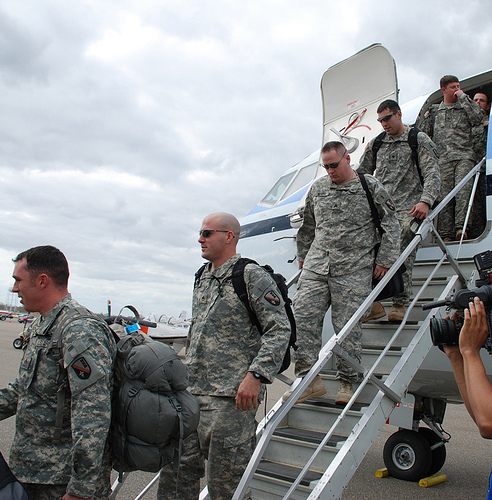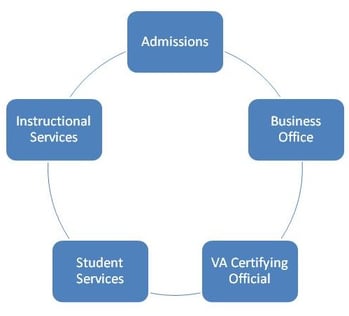Published on
Veterans Task Force: Making Strides Toward Increasing Veteran Student Retention

Having seen too many camels created by committees that were charged with designing horses (Wiktionary, 2011), I’ve tolerated committee work but avoided it whenever possible. My committee experience would have been monumental if actually a camel had been created because frequently my committee service discussed matters ad infinitum and misplaced the opportunity along the way. Consequently, it was with great trepidation that I was encouraged to serve on an enrollment management committee concerning veterans.
Upon arriving at the organizational meeting, the composition of this team pleased me. Clearly the five areas that had the greatest impact on veterans were represented (see Chart 1, below).
The stated purpose of this committee was to increase, retain, and provide better service to veterans. It immediately became apparent how far we had to go. Each participant saw one small portion of the picture and was oblivious to the rest. We could identify the students using VA benefits but didn’t know how many veterans were attending. Each academic department went its own way regarding credit for military training and experience, and denial was the easiest course. The business office struggled with the tuition assistance program and failed to appreciate the difference between tuition assistance for active duty personnel and VA benefits. Admissions performed their standard presentation and didn’t identify veterans. It was truly a sad state of affairs, and the college had a poor reputation in the community for serving veterans.
A survey of all students began our actions. It simply required the students to hit “reply” if they were a veteran. A fictitious baseline was created for our efforts. Additionally, a modification of the application now asked about veteran status. Consequently, veteran enrollment can now be tracked with “real” numbers rather than simply a guess. Veteran enrollment now exceeds two percent of our head count and continues to grow each term.

Outreach followed. In conjunction with an annual education and employment fair, military recruiters, veteran service representatives, and employment counselors from the Ohio Department of Job and Family Service were invited to campus. The task force shared where we were and what we wanted to accomplish. Most importantly we listened. The recruiters, representatives, and counselors had concerns and suggestions. The most important accomplishment was establishing a dialogue with these folks and a network to help veterans. This outreach continues and has expanded to include veteran organizations like the American Legion, American Veterans (AMVETS), the Veterans of Foreign Wars (VFW), and Disabled American Veterans (DAV) as well as National Guard and reserve components throughout Ohio. We continue to listen.
Social services conducted a focus group of veterans. Adjustment issues exist perhaps prompted by differences in expectations or because of some medical condition. Privacy issues also occur. Frequently military people just don’t want to talk about their experiences even to other military; consequently, they don’t want their service publicized. We’ve probably all met those individuals who are long on stories and shy on experience like the soldier in Garet Trooper (Sadler, 1966). Additionally there are concerns about inappropriate inquiries like combat experiences, deployments, etc. that some service members may chose not to talk about.
Admissions created a webpage specifically for veterans. It has internal links to an admission checklist, VA certifying official, academic advising, career counseling, and disability services as well as external links to resources like Ohio’s GI promise, Military Connection job boards, AARTS, SMARTS, and Servicemembers Opportunity Colleges (SOC). Additionally, with proof of veteran status (ID card or DD214), the application fee is waived.
The task force has begun to explore policy revisions to bring the college into compliance with the SOC agreement. This includes amount of CLEP credit accepted, residency requirements, and credit acceptance for military training and experience. Additionally, the task force has begun to consider cross-training from the VA Certifying Official, the business office clerk in charge of tuition assistance, and the academic veterans’ counselor so that these vital tasks do not fall solely on the shoulders of one individual.
Like Nelson at Trafalgar, the signal for close action has been hoisted (Walder, 1978), as the task force advocates for veterans;
- Business management and health information technologies have been revised to be presented in a completely online format and approval has been sought from the Ohio Board of Regents and the Higher Learning Commission. Other programs are being considered for the transition to an online format.
- A presence has been established at the Wright-Patterson AFB Educational Fair; however, this will become more valuable as more academic program gain distance learning approval.
- Students are recognizing that there are more veterans on campus.
- Liaisons with recruiters, the reserves, the National Guard, Job and Family Services, veteran service counselors, and veteran organizations are beginning to bear fruit.
- Bridges has been built with the Buckeye Military Alliance which is veteran organization at Ohio State University, and our students are encouraged to participate. The organization is presently collecting supplies to be sent to our troops in Afghanistan and Iraq.
- The task force has become a resource for faculty when veteran issues arise.
- We participated in a Veterans Day ceremony on campus.
- A meeting place for veterans is contemplated either physically or in cyberspace.
- An Armed Forces Day event is planned for May 19. This event will not only thank veterans for their service but also provide an avenue to market the college’s programs and benefits.
In 18 months, the Veterans Task Force has accomplished more than many committees at the college. This has been accomplished with merely four meetings. The members of this committee have been empowered to take the initiative for veterans. The successes are their successes; the failures, and there have been some, are mine. Even though I didn’t actually fit in the five areas represented by this task force, I was the only veteran invited … and became their leader. I’m proud of their efforts!
—-
References
Sadler, B. (Composer). (1966). Garet Trooper. [B. Sadler, Performer]
Walder, D. (1978). Nelson. New York: The Dial Press.
Wiktionary. (2011, December 30). A camel is a horse designed by committee. Retrieved April 29, 2012, from http://en.wiktionary.org/wiki/a_camel_is_a_horse_designed_by_a_committee



